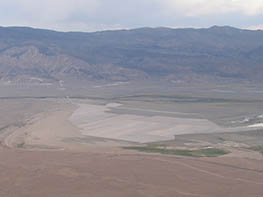Owens Lake

Los Angeles diverted Owens River into the LA Aqueduct in 1913, and by 1924 Owens Lake (formerly supplied by Owens River) was dry. By the mid 1990’s the approximately 110 square mile lake bed had become the largest single source of PM10 Particle Matter pollution in the country.
California lawmakers established the Great Basin Unified Air Pollution Control District (GBUAPCD) in1974 to enforce federal, state and local air quality regulations and insure air quality standards are met. In 1983, the California legislature passed SB 270, codified as section 42316 of the California Health and Safety Code, which gave GBUAPCD authority to undertake reasonable measures to mitigate dust and recover costs from the Los Angeles Department of Water and Power (LADWP).
In 1998, under intense political pressure, LADWP and GBUAPCD signed a State Implementation Plan (SIP) setting forth how LADWP would mitigate dust. Another SIP, amendments to the SIPs and legal challenges by LADWP followed. State courts consistently rejected LADWP’s various challenges and upheld GBUAPCD’s enforcement orders. Although Owens Lake is, ecologically, an integral feature of the Owens watershed, dust mitigation at the lake is not required under the Inyo LA Long Term Water Agreement.
GBUAPCD initially approved three dust mitigation techniques: shallow flooding, managed vegetation (i.e. growing saltgrass), and spreading gravel. DWP was free to decide which method to use on any portion of the lake bed. DWP found that the least expensive alternative was shallow flooding, and used that technique for most of the area it was required to mitigate.
As a by-product of shallow flooding, DWP created large areas of shorebird and waterfowl habitat. It also demonstrated that it could greatly reduce its dependence on Owens Valley water – at least 75,000 acre feet/yr of water which otherwise would have been exported to Los Angeles was allowed to reach the lake.
After several changes in DWP and LA administrations (and much litigation), DWP managed to persuade GBUAPCD to approve a fourth mitigation method: cycles of shallow flooding followed by drying and bulldozing. DWP is now converting areas of shallow flooding to the new technique in the name of “conservation”.
This is not the first time DWP has invoked “water conservation” to justify a project to increase its exports. If increasing water exports is water conservation, we must recognize DWP as one of the greatest conservation organizations in the world!
DWP is thus increasing its dependence on Owens Valley water even as Mayor Garcetti is calling for “sustainability” and seeking to “reduce the amount of imported water used by Angelenos”. The billions of dollars DWP will have to spend on endless bulldozing and manipulation of the bed of Owens Lake could be put to much better use invested in water recycling in Los Angeles, thereby reducing the city’s dependence on Owens Valley water. The most cost-effective way to mitigate dust would be to let the lake fill as Los Angeles overcomes its addiction to imported water.
